
A small selection of our exhibits
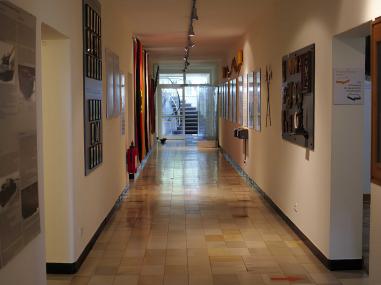
On an area of almost 700 m², numerous display boards and approx. 1700 exhibits explain the Bundeswehr’s understanding of tradition, the development of the military in the Lippe region, the history of the location of the barracks in the municipality of Augustdorf and the history of the Bundeswehr from formation to integration in the alliance up to the order of the armed forces in today's time explained and presented. In the exhibition of the Augustdorfer battalions and independent units, which have since been dissolved, one can empathize with the everyday life of soldiers over the course of time. In addition to special military features - such as a needle gun from 1841 - personalized objects from the contemporary history of Generals Wolf-Joachim Claus and Erwin Rommel enrich the exhibition.
Tip: If you click on an image, you will get an enlarged view of the corresponding image.
The namesake "GFM Rommel"
With the consent of the Federal Minister of Defense, barracks of the Bundeswehr can be named after personalities who have rendered services to freedom and justice through their overall work or an outstanding act.
It should be noted that these soldiers through
- Safeguarding and respecting human dignity
- Live and act according to soldierly virtues such as loyalty, bravery,
- obedience, comradeship, truthfulness, discretion, caring and
- Love for home and fatherland
have earned.
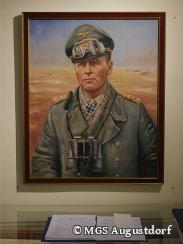
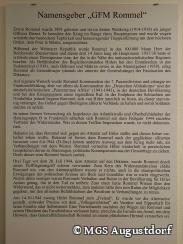
On July 20, 1961, the former northern camp of the Senne military training area, now used by the German Armed Forces, was given the name "Generalfeldmarschall Rommel Kaserne" in the presence of Erwin Rommel's widow and son.

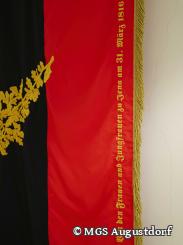
The "unique flag"
A copy of the flag of the Jena Ur-Burschenschaft. One of the very few copies in the collection. With this flag, more than 450 students from the German Confederation marched to the Wartburg near Eisenach in Thuringia on October 18, 1817 for the so-called "Wartburg Festival". But this festival was not a folk festival. It was a purely student event with a distinctly Protestant character. Many speeches expressed the displeasure and disappointment that had filled the students since the wars of liberation in 1813.
They had linked their sacrifice in the fight against Napoleon with the hope of a united and free Germany, but none of the promises made to them in 1813 had been kept. This flag is the origin of our black, red and gold national flag.
An M15 uniform from 1916
An M 1915 uniform from 1916. This uniform belonged to Paul Meyer, a teacher from Herford and a lieutenant in World War I. The peaked cap bears the Lippe cockade. At that time, Lieutenant Meyer was a MG weapons officer in the 55th Infantry Regiment.
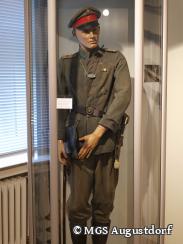
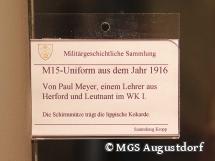
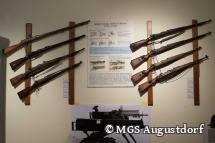
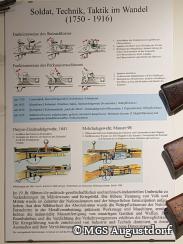
The "Wall of old Rifles"
On this wall you can see German military rifles from the mid-19th century to the first half of the 20th century. From the Dreyse needle gun of 1841, which was the first mass-produced breech-loader suitable for military use, to the rifle 88, the first multi-loader with a magazine well for five rounds on a strip magazine and the rifle 98 in various variants, it was the standard weapon of the German federal troops in World War I and the Reichswehr to the legendary Karabiner 98k, the standard weapon of the German Wehrmacht in World War II.
The Landwehr training camp - north camp - new camp - GFM Rommel barracks
The Landwehr training camp, built in early 1937, had a capacity for up to 1000 soldiers. It was intended as accommodation for the practicing Landwehr battalions from the area of the VI. Army Corps in Munster. It quickly became apparent that the camp was too small for the rapidly growing Wehrmacht, and so the first extensions began in the summer of 1937.
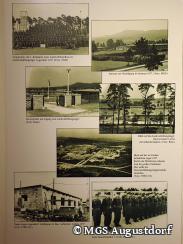
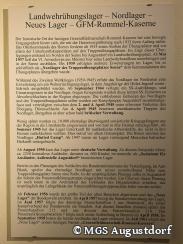
The camp was now constantly being expanded and offered space for up to 16,000 soldiers by the end of the Second World War. At the end of 1939 it was given the name North Camp of the Senne Training Area.
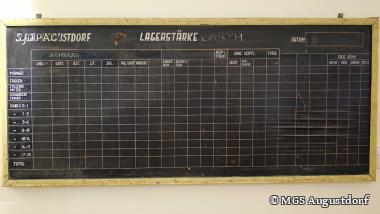
The old table of camp strength
After American troops had liberated the former Soviet prisoner of war camp Stalag 326 in Stukenbrock-Senne on April 2nd, 1945, they then transferred 10,000 former prisoners to the north camp, which had been evacuated by German troops since April 4th. Here in the collective camp they should be registered and wait to be returned home.
After the return of former Russian prisoners of war in mid-1945, the camp became a lodging camp for foreigners. The former foreign workers who were not willing to return were instructed here. They were mainly Poles, which is why the unofficial name of the northern camp became “Polenlager”. But the camp was also populated by Ukrainians, Yugoslavs, Hungarians, Estonians, Latvians and Lithuanians. In the middle of 1947, a large number of Poles were transported back to their homeland by the British military government. The Augustdorf camp now served primarily as accommodation for people from the Baltic countries. After the remaining foreigners had left the camp on September 30th, 1958, the entire former camp complex of the north camp of the Bundeswehr was available.
The plaque exhibited here hung in this former "foreigners' camp". At the time, it was used to document the daily occupancy rate.
The rapid-fire pistol C-96 & SG 84/98
Finds from Augustdorf are stored in these showcases. Among other things you can see here
- the remains of a Mauser C96 rapid-fire pistol. This weapon was most likely used during the battles around Augustdorf in early April 1945 as it was found on one of the former battlefields.
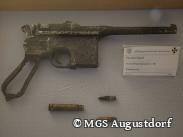
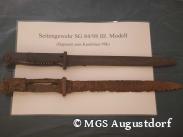
Not only the German troops received the "C 96" in the First World War. It was also delivered in large numbers to other countries, including Turkey, Mexico and China. So it became a great commercial success for the Mauser company, although it never became the standard weapon of the German army.
- the remains of a bayonet SG 84/ 98, III. Model. This bayonet was found during earthworks in the northwest of the Generalfeldmarschall Rommel barracks. The III shown here. The model of the bayonet actually produced for the rifle 98 was a modification for the Wehrmacht's carbine 98 short. Since many different units of the Wehrmacht and from 1944 the Waffen-SS were stationed in the former north camp from May 1937 to early April 1945, this bayonet cannot be assigned to any specific event.
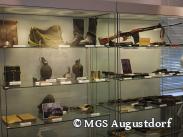
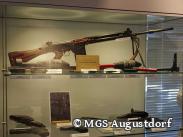
The showcases of historical treasures
Equipment and handguns from the time when the Bundeswehr was being set up are on display in these showcases. From cookware, which has been used by the German armed forces almost unchanged since the First World War to this day, via
an identification tag with a built-in radiation dosimeter to the Colt 1911, an American weapon aid that was used by the Bundeswehr as a P51 and P52 pistol in .45ACP caliber (11.43mm x 23). In these showcases alone we present over 40 exhibits.
The field communication at that time
Here we show, among other things, the field telephone local operation / central operation. This is a telephone that was specially developed for use in the field by the Bundeswehr.
The visitor also sees an AN/PRC-6 handheld radio, nicknamed "Banana", which was used by the US military from the late Korean War to the Vietnam War and was also used initially by the German Army.
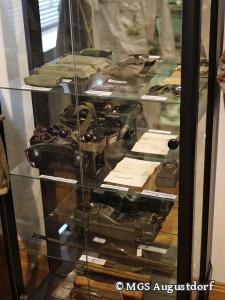
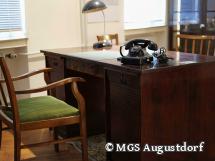
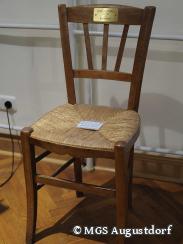
The chair where Rommel once sat
In the exhibition area of the former 7th Armored Reconnaissance Battalion, next to the battalion commander's desk is a chair on which Field Marshal Erwin Rommel is said to have sat at the end of May 1940 during the "Dunkirk halt". The landlord of the inn in northern France where Rommel had his command post set up at the time had kept it and marked it with a brass plate to match.
The "Last Shot" - Leopard 1 A5
On November 19, 1991, the last 105 mm cartridge was fired from a Leopard 1 A5 main battle tank on combat lane 9 of the Bergen military training area by the then battalion commander of the 7th Armored Reconnaissance Battalion. The occasion was the conversion of the battalion to the Leopard 2 A4 main battle tank. This last 105 mm brass case is on display in the collection, but also the case base of the first 120 mm cartridge fired in the battalion.
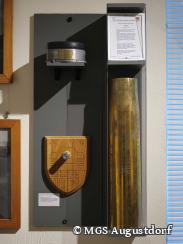
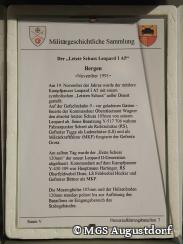
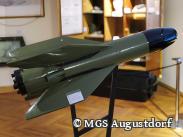
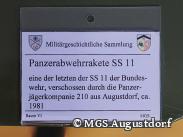
The SS 11 anti-tank missile
Here, in the exhibition of Panzerjägerkompanie 210, which was decommissioned in 1996, you can see, among other things, an anti-tank guided missile of the "SS11" type.
It was shot down in the period from June 15 to 16, 1981 by Panzerjägerkompanie 210 at the last central Bundeswehr school shooting with SS 11 anti-tank guided missiles at the Bergen military training area.
If we have now piqued your interest, please visit us personally as part of a guided tour of our collection.
Further information and the possibility to do so can be found here.


